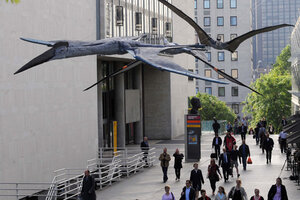Huge pterosaurs may have pole-vaulted to get off the ground
Giraffe-sized pterosaurs could have pole-vaulted with their arms to launch themselves into the sky, scientists say.

In this file photo from June, pterosaur models are on display at London's South Bank, as part of the Royal Society's 350th anniversary celebrations.
Zuma Press/Newscom
Giraffe-sized pterosaurs may have pole-vaulted with their arms to launch themselves, just as vampire bats do, scientists now suggest.
Once airborne, these giant reptiles could have flown vast distances, even crossing continents, they added.
Pterosaurs were prehistoric winged reptiles that dominated the skies during the age of dinosaurs, and went extinct at the same time their brethren did 65 million years ago. The largest pterosaur reached the height of a giraffe, raising controversy as to whether such giant beasts could ever actually fly.
"People had assumed for many years that all pterosaurs could take off and fly, although there were disagreements about the specifics of it," said researcher Mark Witton, a paleontologist at the University of Portsmouth in England. "It's only recently that people started claiming that giant pterosaurs were flightless."
Recent assertions that pterosaurs were flightless were based on assumptions that they would have taken off like birds.
"Most birds take off either by running to pick up speed and jumping into the air before flapping wildly — or, if they're small enough, they may simply launch themselves into the air from a standstill," Witton told LiveScience. "Previous theories suggested that giant pterosaurs were too big and heavy to perform either of these maneuvers and therefore they would have remained on the ground."
Witton's colleague Michael Habib, a biomechanicist at Chatham University in Pittsburgh, published work last year suggesting these creatures had used a pole-vaulting maneuver. The new study involves models detailing exactly how this happened and how it compared with living birds today.
"These creatures were not birds — they were flying reptiles with a distinctly different skeletal structure, wing proportion and muscle mass. They would have achieved flight in a completely different way to birds," Witton said.
Meaty flight muscles
The researchers suggest that with their huge wing muscles, pterosaurs could easily have launched themselves into the air despite their massive size and weight. They would have essentially pole-vaulted over their wings using their leg muscles and pushed off from the ground using their powerful arm muscles.
A pterosaur's flight muscles alone would have weighed about 110 pounds (50 kilograms), accounting for 20 percent of the animal's total mass. Result: The muscles would've provided tremendous power and lift, according to Witton.
"By using their arms as the main engines for launching instead of their legs, they use the flight muscles, the strongest in their bodies, to take off, and that gives them potential to launch much greater weight into the air," Habib said. "This may explain how pterosaurs became so much larger than any other flying animals known."
Their extraordinarily strong bones also could have helped with pole-vaulting and flight. For instance, the team compared the largest bone in the wings of the biggest living birds — the griffon vulture, mute swan and royal albatross — with that of the giant pterosaur Quetzalcoatlus. The extinct pterosaur's wing bone was more than twice the strength relative to weight of the mute swan's and royal albatross's, and nearly twice the strength of the griffon vulture.
"Pterosaurs had incredibly strong skeletons — for their weight, they're probably amongst the strongest ever evolved," Witton said. "And unlike birds, where the wings become relatively weak as they grow in size, those of pterosaurs do the opposite — they become stronger. As pterosaurs became larger, they reinforced their wings and expanded their flight muscles to ensure they could keep flying."
Weight estimates refined
Using fossilized remains of the flying reptiles, the researchers estimated size and weight and calculated bone strength and mechanics, as well as potential flight performance.
"One of the reasons why pterosaur research is so tricky is that there is very little in the way of fossilized remains," Witton said. "We're working with [an] extremely small number of fossil specimens. You could take all the giant pterosaur fossils in the world and fit them on to a coffee table."
These animals might have been a bit smaller and lighter than previously thought, which helps change the premise as to whether they could fly. Researchers had suggested the giant pterosaurs could have been roughly 19.5 feet (6 meters) tall with wingspans of up to 39 feet (12 m) and weighing of up to 1,200 pounds (544 kg). But Witton and Habib argue that more realistic measurements for a pterosaur would be roughly 16.5 feet (5 m) high with a wingspan of nearly 33 feet (10 m) and a weight of 440 to 550 pounds (200 to 250 kg).
"Weight estimates based on a 12-meter wingspan will be almost twice that based on 10 meters, so an accurate assessment is vital," Witton said. "They're still really big, just not as big as we thought they were."
They concluded that pterosaurs could not only fly, but they could do so extremely well, potentially traveling huge distances and even crossing continents. They probably did not need to flap continuously to remain aloft, but flapped powerfully in short bursts, with their large size enabling them to achieve rapid cruising speeds.
"All the direct data we have on pterosaurs, even the largest, suggests they were capable of flying," Witton said. "And after almost a century in the doldrums, we're starting to see far more progressive research on pterosaurs. It's not quite a revolution but we're certainly going through something of a renaissance."
Witton and Habib detailed their findings online Nov. 15 in the journal PLoS ONE.
- 25 Amazing Ancient Beasts
- Top 10 Beasts and Dragons: How Reality Made Myth
- Gallery: Dinosaur Drawings
IN PICTURES: Fearsome dinosaurs
